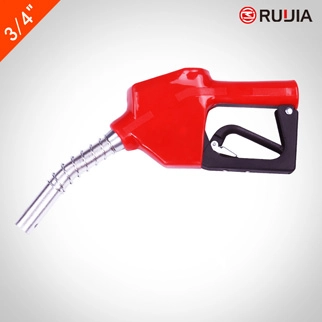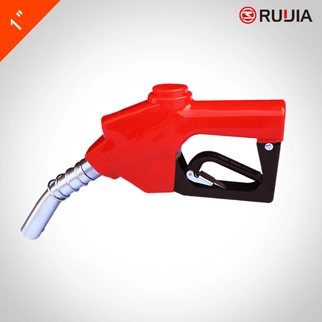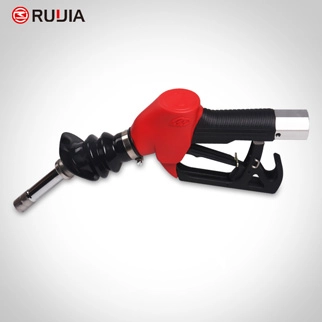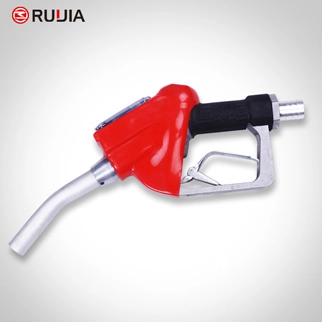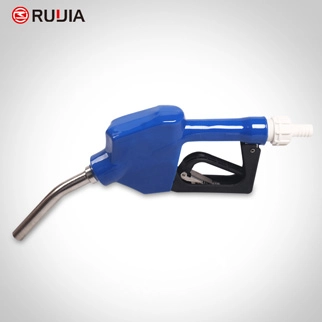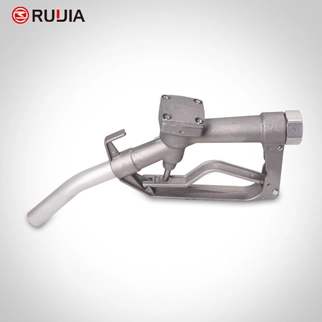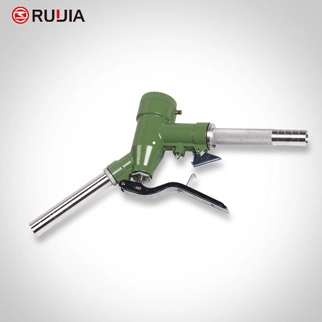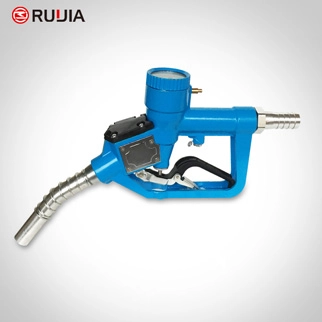- 20+ Years Of History
- 30+ Countries
- 50000 Yearly Production
What Is a Fuel Nozzle?
A fuel nozzle is a critical component of the fueling process, serving as the interface between the fuel dispenser and the vehicle’s fuel tank. While it may seem like a simple device, the fuel nozzle is a sophisticated piece of engineering designed to ensure safe, efficient, and accurate fuel delivery. Its role extends beyond merely transferring fuel—it includes mechanisms to prevent spills, manage pressure, and comply with environmental and safety standards. From the gas pumps at roadside stations to the specialized equipment used in industrial and military applications, fuel nozzles are indispensable in modern transportation and energy systems. This article delves into the definition, components, types, functions, safety features, historical development, technological advancements, and future trends of fuel nozzles, highlighting their significance in the global fueling industry.
Definition and Basic Function
A fuel nozzle is a device that connects the fuel dispenser to a vehicle’s fuel tank, facilitating the controlled transfer of fuel. It is typically attached to a hose and features a spout that fits into the vehicle’s fuel inlet. The primary function of a fuel nozzle is to deliver fuel safely and efficiently, while also incorporating mechanisms to prevent overfilling, spills, and other hazards.
The design of a fuel nozzle is tailored to the type of fuel it handles—gasoline, diesel, compressed natural gas (CNG), or even hydrogen—and the specific requirements of the vehicle or system it serves. Modern fuel nozzles are equipped with advanced technologies to enhance performance, reduce environmental impact, and improve user experience. Despite their simplicity in appearance, fuel nozzles are complex devices that must withstand high pressures, extreme temperatures, and repeated use while maintaining reliability and safety.
Components of a Fuel Nozzle
A fuel nozzle consists of several key components, each playing a critical role in its operation. Understanding these parts helps explain how fuel nozzles function and why they are essential in the fueling process.
1. Handle
The handle is the part of the nozzle that the user grips during refueling. It is typically made of durable plastic or rubber to provide a secure and comfortable grip. The handle may also include a trigger mechanism that controls the flow of fuel. When the user pulls the trigger, it opens the valve, allowing fuel to flow through the nozzle. Some modern nozzles feature ergonomic designs to reduce fatigue during extended use.
2. Spout and Nozzle Tip
The spout is the elongated part of the nozzle that connects to the vehicle’s fuel tank. It is usually made of metal or reinforced plastic to withstand the pressure and temperature of the fuel. The nozzle tip is the end of the spout that fits into the vehicle’s fuel inlet. It is designed to create a tight seal, preventing fuel leakage and ensuring a smooth flow. The shape and size of the nozzle tip vary depending on the type of vehicle and fuel being used. For example, gasoline nozzles have a standard shape, while diesel nozzles are larger and have a different design to prevent accidental misfuelling.
3. Anti-Overfill System
One of the most important features of a fuel nozzle is the anti-overfill system, which prevents the tank from being overfilled. This system works by detecting when the fuel level in the tank reaches the top. A sensor in the nozzle tip senses the rising fuel level and automatically closes the valve, stopping the flow of fuel. This mechanism not only protects the vehicle from overflow but also reduces the risk of fuel spills, which can cause environmental damage and safety hazards.
4. Pressure Relief Valve
Fuel nozzles are equipped with a pressure relief valve to manage the pressure within the system. This valve releases excess pressure to prevent damage to the nozzle or the vehicle’s fuel tank. It ensures that fuel is delivered smoothly and consistently, even under varying conditions.
5. Hose and Coupling
The hose connects the nozzle to the fuel dispenser and is typically made of reinforced rubber or synthetic materials to withstand the rigors of frequent use. The coupling at the end of the hose allows the nozzle to be attached to the dispenser. Some modern nozzles feature quick-connect couplings for faster and easier attachment.
6. Safety Mechanisms
Fuel nozzles incorporate various safety mechanisms to prevent accidents. These include static electricity dissipation systems, which neutralize static charges that could ignite fuel vapors. Additionally, many nozzles are designed with fireproof materials to reduce the risk of fire in case of a malfunction.
Types of Fuel Nozzles
Fuel nozzles are not one-size-fits-all; they are designed to accommodate different types of fuels and vehicle requirements. The following are the most common types of fuel nozzles:
1. Gasoline Fuel Nozzles
Gasoline nozzles are the most widely used type, found at traditional gas stations. They are designed to handle the volatility of gasoline and are equipped with features such as anti-overfill systems and pressure relief valves. These nozzles are typically smaller and lighter than diesel nozzles, making them easy to handle.
2. Diesel Fuel Nozzles
Diesel nozzles are larger and have a different shape compared to gasoline nozzles. This design prevents accidental misfuelling, as gasoline nozzles cannot fit into diesel tanks. Diesel nozzles are also built to withstand higher pressures and are often equipped with diesel particulate filters to reduce emissions.
3. Compressed Natural Gas (CNG) Nozzles
CNG nozzles are used to refuel vehicles powered by compressed natural gas. These nozzles are designed to handle the high-pressure nature of CNG and include specialized valves and pressure regulators to ensure safe and efficient fueling. They are commonly found at CNG refueling stations and are used in public transportation and fleet vehicles.
4. Hydrogen Fuel Nozzles
Hydrogen fuel nozzles are used for hydrogen-powered vehicles. They are designed to handle the unique properties of hydrogen, including its high flammability and low density. These nozzles are equipped with temperature and pressure sensors to ensure safe and precise fuel delivery. They are often used in hydrogen refueling stations, which are becoming increasingly common as hydrogen fuel technology advances.
5. Electric Vehicle (EV) Charging Nozzles
While not traditional fuel nozzles, EV charging nozzles serve a similar function in the context of electric vehicles. These devices connect the vehicle to a charging station and are designed to deliver electricity efficiently. They come in various forms, such as Level 1, Level 2, and DC fast chargers, each offering different charging speeds and power outputs.
6. Specialized Industrial Nozzles
In industrial and commercial settings, fuel nozzles are often customized to meet specific requirements. For example, heavy-duty nozzles are used in construction and mining equipment, while marine nozzles are designed for use on boats and ships. These nozzles are built to withstand harsh environments and are often equipped with corrosion-resistant materials.
Functions and Importance of Fuel Nozzles
Fuel nozzles play a crucial role in the fueling process, contributing to the efficiency, safety, and environmental responsibility of fuel delivery. Their primary functions include:
1. Fuel Delivery
The most obvious function of a fuel nozzle is to transfer fuel from the dispenser to the vehicle’s tank. This process must be precise and controlled to ensure that the correct amount of fuel is delivered and that the vehicle is filled to the appropriate level.
2. Preventing Spills and Overfilling
Fuel nozzles are equipped with anti-overfill systems that detect when the tank is full and automatically stop the flow of fuel. This prevents spills, which can cause environmental damage and pose safety risks. By minimizing fuel waste, these systems also help reduce costs for both consumers and fuel providers.
3. Regulating Fuel Flow
Fuel nozzles include pressure regulators that maintain a consistent flow rate, ensuring that fuel is delivered smoothly and without excessive pressure. This is particularly important for vehicles with sensitive fuel systems, as high pressure can cause damage to the tank or engine.
4. Ensuring Safety
Safety is a top priority in the design of fuel nozzles. Features such as static electricity dissipation systems and fireproof materials help prevent accidents. Additionally, pressure relief valves protect the system from overpressurization, reducing the risk of explosions or leaks.
5. Environmental Protection
Modern fuel nozzles are designed to minimize their environmental impact. For example, vapor recovery systems capture fuel vapors during refueling, preventing them from escaping into the atmosphere. This helps reduce air pollution and comply with environmental regulations.
Safety Features of Fuel Nozzles
Given the flammable nature of fuel, safety is a critical aspect of fuel nozzle design. The following are some of the key safety features incorporated into modern fuel nozzles:
1. Anti-Overfill System
As mentioned earlier, the anti-overfill system is a vital safety feature that prevents fuel from spilling over. This system uses a sensor in the nozzle tip to detect when the tank is full and automatically stops the flow of fuel. By doing so, it reduces the risk of fuel contamination, environmental damage, and fire hazards.
2. Static Electricity Dissipation
Static electricity can build up during the fueling process, posing a risk of sparks that could ignite fuel vapors. To mitigate this, fuel nozzles are equipped with grounding systems that safely discharge static electricity. This is typically achieved through a grounding wire connected to the nozzle and the vehicle, ensuring that any static charge is neutralized before it can cause a hazard.
3. Fireproof Design
Fuel nozzles are constructed using flame-resistant materials to minimize the risk of fire. The electrical components are also designed to prevent sparks, and many nozzles include emergency shut-off systems that can be activated in case of a malfunction or accident. These systems immediately stop the flow of fuel, reducing the likelihood of fire or explosion.
4. Pressure Relief Valves
Pressure relief valves are another critical safety feature that prevents excessive pressure buildup within the fueling system. These valves release excess pressure in the system, ensuring that the nozzle remains functional and safe. By maintaining a stable pressure level, these valves help prevent ruptures or explosions that could occur if the system were to overpressurize.
5. Leak Detection and Prevention
Modern fuel nozzles are designed with leak detection systems that monitor for any signs of fuel leakage. If a leak is detected, the system can automatically shut off the fuel flow, preventing further damage and ensuring the safety of the user and the environment.
Historical Development of Fuel Nozzles
The concept of a fuel nozzle dates back to the early 20th century, when the rise of the automobile industry created a need for a reliable method of fuel delivery. The first fuel dispensers were simple devices that required manual operation, with no advanced features such as anti-overfill systems or pressure regulators. However, as vehicle usage increased and fuel efficiency became a priority, the design of fuel nozzles evolved to meet the demands of both consumers and industry standards.
The introduction of mechanical anti-overfill systems in the mid-20th century marked a significant advancement in fuel nozzle technology. These systems used a float mechanism to detect when the fuel tank was full and automatically stop the flow of fuel. Over time, electronic sensors and digital controls were integrated into fuel nozzles, improving accuracy and reliability.
In the late 20th and early 21st centuries, the focus on environmental protection led to the development of vapor recovery systems and low-emission fuel nozzles. These innovations helped reduce fuel evaporation and minimize the release of harmful pollutants into the atmosphere. Today, fuel nozzles are not only safer and more efficient but also more environmentally friendly, reflecting the broader trends in the energy sector.
Technological Advancements in Fuel Nozzles
Modern fuel nozzles have benefited from significant technological advancements, making them more efficient, reliable, and user-friendly. Some of the key innovations include:
1. Smart Fuel Nozzles
Smart fuel nozzles are equipped with sensors and digital displays that provide real-time information about fuel flow, temperature, and pressure. These nozzles can also integrate with payment systems, allowing for seamless transactions. Some models even include IoT connectivity, enabling remote monitoring and maintenance.
2. Automated Fueling Systems
Automated fueling systems use robotic arms or self-service nozzles to deliver fuel without the need for manual intervention. These systems are particularly useful in high-traffic areas such as truck stops and airports, where efficiency and speed are critical.
3. Alternative Fuel Compatibility
With the growing demand for cleaner energy sources, fuel nozzles are being designed to accommodate alternative fuels such as CNG, hydrogen, and biofuels. These nozzles are equipped with specialized valves and pressure regulators to ensure safe and efficient fueling.
4. Eco-Friendly Materials
Manufacturers are increasingly using biodegradable and recyclable materials in the production of fuel nozzles. These materials help reduce the environmental impact of fueling operations while maintaining the durability and performance of the nozzle.
5. Enhanced Safety Features
Modern fuel nozzles incorporate advanced safety features such as smart sensors that detect fuel leaks and automatic shut-off mechanisms that respond to emergencies. These features enhance the safety of both the user and the environment.
Applications Beyond Traditional Gas Stations
While fuel nozzles are most commonly associated with gas stations, their applications extend to a wide range of industries and settings. Some of the key areas where fuel nozzles are used include:
1. Industrial and Commercial Vehicles
Fuel nozzles are essential for refueling trucks, buses, and heavy machinery used in construction, agriculture, and logistics. These nozzles are designed to handle large volumes of fuel and are often equipped with high-capacity pumps and durable materials to withstand harsh conditions.
2. Military and Emergency Services
In military and emergency response operations, fuel nozzles are used to refuel tanks, aircraft, and rescue vehicles. These nozzles are designed to operate in extreme environments and are often equipped with specialized features to ensure reliability in critical situations.
3. Marine and Aviation
Fuel nozzles are used in marine and aviation fueling systems, where precision and safety are paramount. Marine nozzles are designed to withstand saltwater corrosion, while aviation nozzles are built to handle the high pressures and temperatures associated with aircraft fueling.
4. Electric Vehicle Charging
Although not traditional fuel nozzles, EV charging nozzles serve a similar function in the context of electric vehicles. These devices are designed to deliver electricity efficiently and are often equipped with smart charging systems that optimize energy use.
5. Specialized Fueling Stations
In remote or off-grid locations, fuel nozzles are used in mobile fueling units and portable fuel tanks. These nozzles are designed to be lightweight and easy to transport, making them ideal for use in areas with limited infrastructure.
Maintenance and Troubleshooting of Fuel Nozzles
Regular maintenance is essential to ensure the optimal performance and longevity of fuel nozzles. Neglecting maintenance can lead to malfunctions, safety hazards, and inaccurate fuel measurements. The following are key aspects of fuel nozzle maintenance:
1. Routine Inspections
Operators should conduct daily inspections of fuel nozzles to check for signs of wear, leaks, or damage. This includes examining the spout, nozzle tip, and pressure relief valve for any issues that could affect performance. Electrical components, such as sensors and grounding systems, should also be inspected to ensure they are functioning correctly.
2. Cleaning and Lubrication
Fuel nozzles should be cleaned regularly to prevent the buildup of dirt, debris, or fuel residues that could clog the system. Lubricating moving parts, such as the trigger mechanism and valve, helps maintain smooth operation and extends the lifespan of the nozzle. Operators should follow manufacturer guidelines for cleaning and lubrication schedules.
3. Calibration of Sensors
Accurate fuel measurement is crucial for fair billing and customer trust. Sensors in fuel nozzles should be calibrated periodically to ensure they provide precise readings. Calibration involves comparing the nozzle’s measurements to a known standard and adjusting the system as needed. This process helps prevent discrepancies and ensures compliance with regulatory standards.
4. Troubleshooting Common Issues
Despite regular maintenance, fuel nozzles may encounter issues that require troubleshooting. Common problems include low fuel pressure, inaccurate measurements, and malfunctioning safety systems. For example, if a nozzle fails to dispense fuel, the operator should check the pump motor and electrical connections. If the sensor is inaccurate, recalibration or replacement may be necessary. Promptly addressing these issues helps maintain the reliability and performance of the nozzle.
Challenges and Future Trends
While fuel nozzles have come a long way, they still face several challenges that must be addressed to ensure their continued relevance in the evolving energy landscape.
1. Environmental Regulations
As governments implement stricter environmental regulations, fuel nozzles must adapt to meet new standards. This includes reducing emissions, minimizing fuel evaporation, and using eco-friendly materials. Manufacturers are developing low-emission nozzles and vapor recovery systems to comply with these regulations.
2. Technological Integration
The integration of smart technologies into fuel nozzles presents both opportunities and challenges. While smart nozzles offer improved efficiency and user experience, they also require advanced infrastructure and cybersecurity measures to protect against potential vulnerabilities.
3. Alternative Fuels
The rise of electric vehicles and hydrogen fuel is reshaping the fueling industry. Fuel nozzles must evolve to accommodate these new energy sources, which require specialized designs and safety protocols. This shift also creates opportunities for innovation in nozzle technology.
4. Global Accessibility
In remote or underdeveloped regions, access to fuel nozzles can be limited. Mobile fueling units and portable nozzles are being developed to address this challenge, providing fuel to areas with limited infrastructure.
Conclusion
A fuel nozzle is far more than a simple device for transferring fuel—it is a critical component of the modern energy and transportation systems. From its basic function of delivering fuel to the vehicle’s tank to its advanced safety features and technological innovations, the fuel nozzle plays a vital role in ensuring the efficiency, safety, and environmental responsibility of fueling operations.
As the energy sector continues to evolve, fuel nozzles will remain at the forefront of innovation, adapting to new technologies, alternative fuels, and environmental regulations. Whether in a gas station, a military base, or an industrial facility, fuel nozzles are essential in keeping the world moving. Their design, functionality, and importance underscore the intricate balance between engineering, safety, and sustainability in the modern era. As we look to the future, the continued development of fuel nozzles will be crucial in meeting the demands of a rapidly changing energy landscape.
